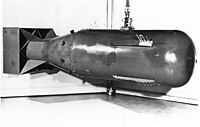
Photo from wikipedia
Abstract Gd2Zr2O7 ceramic is considered as one of the most promising host minerals for the immobilization of high-level radioactive wastes. Here, the effects of grain size on the aqueous durability… Click to show full abstract
Abstract Gd2Zr2O7 ceramic is considered as one of the most promising host minerals for the immobilization of high-level radioactive wastes. Here, the effects of grain size on the aqueous durability of Gd2Zr2O7 ceramics were studied. Two kinds of leaching experiments were used to research Gd2Zr2O7 ceramic powders and bulks with different grain sizes (5 nm, 78 nm, 1 μm and 18 μm). The results demonstrate that the normalized leaching rates decrease with the increase of grain size. Through characterization and analysis, it is concluded that the hydrolysis reactions of Gd2Zr2O7 occur in the leaching experiment and the hydrolysates are Gd(OH)3 and Zr(OH)4. Besides, all the samples after leaching exhibit slight lattice contraction, which decreases with the increase of crystal grain size. The influence of leaching on the elemental distribution is most significant for the sample with grain size of 5 nm. This study has theoretical guiding significance for the application of Gd2Zr2O7 immobilization.
Journal Title: Ceramics International
Year Published: 2021
Link to full text (if available)
Share on Social Media: Sign Up to like & get
recommendations!